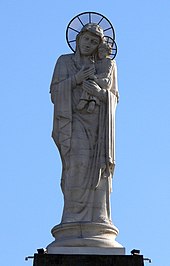Haskovo
Haskovo
Хасково | |
|---|---|
| Country | |
| Province (Oblast) | Haskovo |
| Government | |
| • Mayor | Georgi Ivanov |
| Elevation | 196 m (643 ft) |
| Population | |
| • Total | 77,050 |
| Time zone | UTC+2 (EET) |
| • Summer (DST) | UTC+3 (EEST) |
| Postal Code | 6300 |
| Area code | 038 |
Haskovo (Bulgarian: Хасково), is a city, an administrative centre of the homonymous Haskovo Province in southern Bulgaria, not far from the borders with Greece and Turkey. As of December 2009, it has a population of 77,050 inhabitants.[1][2][3]
Haskovo celebrated its 1000th anniversary in 1985. To mark the event, a new clock tower was erected in the centre of the town. In medieval times it was known for the nearby Uzundzhovo fair, famous in all of Bulgaria.


History
According to the archeologists, the area of Haskovo was originally settled about seven thousand years ago. In and around Haskovo, evidence has been preserved that confirms its long history during the prehistoric, Thracian, Greek, Roman, and Byzantine periods.
In the 9th century — during the First Bulgarian Empire — a fortress was built in Haskovo that soon was transformed into a town. The town was located at the centre of a sizable region between the Klokotnitsa, Harmanliyska, and Maritsa rivers. In 1395 the Eski cami (the Old Mosque) was built as one of the first in the Balkans. It is interesting that its minaret is slightly inclined.
In 1782, the town was known as Marsa. By 1830, it was known as Uzundja-ova.[4] Many[who?] speculate that the current name came from the Arabic word "has" (هس; possession) and the Turkish word "köy" (village) (Turkish: Hasköy). Several historians have ascertained that the Turkish word "has" has roots to the meaning "clean." Strengthening this argument, the town was called "Clean Town" during the Bulgarian Revival period. The Turkish "köy" was subsequently substituted with the Bulgarian (and common Slavic) placename suffix "-ovo".
Most Bulgarians began to re-settle in Haskovo at the beginning of the nineteenth century. At this time, the settlement was a trading centre for merchants from Edirne, Enos, and Istanbul. Slowly, the area acquired a strong reputation for producing cotton materials, silk fabrics, and carpets.
After the liberation in 1878 Haskovo became a centre of high-quality tobacco region. However, now there is no cigarette production in the region as the once big Tobacco company "BT Haskovo" was closed. Nowadays there are some enterprises producing food, machinery and fabric.
Haskovo Cove in Greenwich Island in the South Shetland Islands, Antarctica is named for the city of Haskovo.
Population
The population of Haskovo during the first decade after the liberation of Bulgaria exceeded 10,000, being 14,191 in 1887.[5] Since then it started growing decade by decade, mostly because of the migrants from the rural areas and the surrounding smaller towns, reaching its peak in 1985 exceeding 85,000.[2]
| Haskovo | |||||||||||||||
|---|---|---|---|---|---|---|---|---|---|---|---|---|---|---|---|
| Year | 1887 | 1910 | 1934 | 1946 | 1956 | 1965 | 1975 | 1985 | 1992 | 2001 | 2005 | 2009 | 2011 | 2021 | |
| Population | 14,191 | 15,067 | 26,516 | 27,435 | 38,812 | 57,681 | 75,136 | 87,763 | 80,700 | 80,870 | 78,668 | 77,050 | ?? | ?? | |
| Highest number ?? in ?? | |||||||||||||||
| Sources: National Statistical Institute,[1] citypopulation.de,[2] pop-stat.mashke.org,[3] Bulgarian Academy of Sciences[5] | |||||||||||||||
Culture
The cultural life in the town is presented by the newly renovated Ivan Dimov Dramatic Theatre, the historical museum and an art gallery. The annual Colourful Thrace Sings and Dances folk festival takes place in the nearby park Kenana.
A 32-metre-high monument of the Mother of God and the Infant Jesus was erected on the Hill of Youth near Haskovo in 2003. The monument was inaugurated on 8 September on the occasion of the Nativity of Holy Virgin Mary, when the day of the town of Haskovo is celebrated. It entered the Guinness Book of Records as the highest monument to Our Lady in the world.
The town centre has recently been the subject of many investments and renovation.
Municipal landmarks include the Thracian Aleksandrovo tomb as well as Uzundzhovo's Church of the Assumption, built originally as a mosque during Ottoman times.
Notable natives
- Tane Nikolov (1873–1947), revolutionary
- Asen Zlatarov (1885–1936), scientist
- Anyu Angelov (1942), acting Minister of Defence
- Nedyalka Simeonovа (1901–1959), violinist
- Nemzade Hatice Hanımsultan (1925–2000), Ottoman princess
- Tsvetan Motev (b. 1964), bronze medalist from International Mathematical Olympiad 1983
- Stanimir Stoilov (b. 1967), footballer and football manager
- Krassen Krastev (b. 1973), dancer and choreographer
- Grigor Dimitrov (b. 1991), tennis player; 2008 Wimbledon and US Open junior champion
International relations
Twin towns — Sister cities
Haskovo is twinned with:
 Abington, Pennsylvania,[disambiguation needed] USA
Abington, Pennsylvania,[disambiguation needed] USA Alexandroupoli, Greece
Alexandroupoli, Greece Edirne, Turkey
Edirne, Turkey Enguera, Spain
Enguera, Spain Leicester, England, United Kingdom
Leicester, England, United Kingdom Novara, Italy
Novara, Italy Tashkent, Uzbekistan
Tashkent, Uzbekistan Bodrum, Turkey
Bodrum, Turkey
Gallery
-
New office building
-
City centre
-
Building
-
Haskovo municipality hall
-
View from Virgin Mary monument
References
- ^ a b c Template:En icon Bulgarian National Statistical Institute - towns in 2009
- ^ a b c d Template:En icon „WorldCityPopulation“
- ^ a b c „pop-stat.mashke.org“
- ^ Arrowsmith, John. Turkey in Europe. 1832.
- ^ a b Template:Bg icon Bulgarian Academy of Sciences









